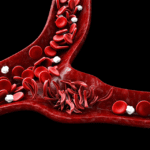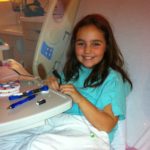New Newborn Screening Approach Allows for Earlier Detection of Menkes Disease
New Newborn Screening Approach Allows for Earlier Detection of Menkes Disease https://pediatricsnationwide.org/wp-content/uploads/2021/03/AdobeStock_115709904_HRBW-web-1024x575.gif 1024 575 Natalie Wilson Natalie Wilson https://pediatricsnationwide.org/wp-content/uploads/2021/06/Natalieheadshot3-2.png- August 25, 2020
- Natalie Wilson

Targeted next generation DNA sequencing can enable improved clinical outcomes for any genetic disorder not detectable through other biochemical newborn screening methods.
Menkes disease is a rare, X-linked recessive pediatric disease caused by gene mutations of the copper transporter gene, ATP7A, leading to low levels of copper in infants’ blood and brain, as well as abnormal levels of certain neurochemicals. The birth prevalence of Menkes disease could potentially be as high as 1 in 8,664 live male births, nearly 250% higher than previously estimated.
At birth, infants affected by Menkes disease appear healthy and typically develop normally for 6 to 10 weeks. Left undetected and untreated, however, Menkes disease can cause connective tissue problems and severe neurological symptoms such as seizures, irreversible brain atrophy and hypotonia. Menkes disease is often fatal by three years of age. Earlier medical intervention in that newborn period could be vital to infants with this condition.
Population-based newborn screening (NBS) enables early, presymptomatic identification of inherited disorders and institution of dietary or medical interventions that reduce morbidity and mortality. While NBS can currently screen simultaneously for numerous metabolic disorders, the availability of NBS for many other potentially treatable infantile-onset disorders such as Menkes disease can be limited by the absence of reliable biochemical signatures amenable to detection by current platforms.
DNA-based NBS approaches employ recent advances in sequencing and interpretive technologies to address this gap. A recent study published in Molecular Genetics and Metabolism Reports by Stephen Kaler, MD, a physician-scientist in the Center for Gene Therapy in the Abigail Wexner Research Institute at Nationwide Children’s Hospital, assessed the potential for NBS of any actionable genetic disorder not detectable through current biochemical newborn screening, focusing on assessing the analytic validity of next generation DNA sequencing (tNGS) assay for Menkes disease. The assay targets the gene ATP7A.
In the study, supported in part by The Menkes Foundation, researchers blindly analyzed dried blood spots from control or from Menkes disease subjects for pathogenic variants in ATP7A, utilizing an analytical method that was optimized to be cost effective and provide rapid turnaround time. The algorithm correctly identified pathogenic ATP7A variants, including missense, nonsense, small insertions/deletions and large copy number variants, in 95.5% of subjects.
“The results of our study support proof-of-concept that primary DNA-based NBS would accurately detect Menkes disease, a disorder for which biochemical detection in the newborn period is problematic,” says Dr. Kaler, who is also a professor of Pediatrics and Genetics at The Ohio State University College of Medicine. “Targeted next generation sequencing for NBS would enable improved Menkes disease clinical outcomes through early detection and eliminate the lengthy, expensive and uncomfortable diagnostic odysseys endured by many affected infants and their parents.”
By establishing a platform for early identification of unscreened disorders to complement current NBS, DNA-based NBS could potentially increase the number of Menkes disease patients identified at birth, allowing for earlier treatment, a critical component correlated with clinical outcome.
The DNA sequencing utilized by the study, tNGS, offers the scalability, speed and resolution to economically reveal risk for nearly any monogenic inherited disorder for which a biochemical analyte is not currently measurable. As a result, tNGS could improve first-tier biochemical tests and reduce false positives by providing supportive confirmatory sequence data relevant to those conditions currently screened. Dr. Kaler’s study provides immediate data for molecular confirmation of numerous biochemically screened conditions.
Dr. Kaler has also recently conducted a Phase 1/2 clinical trial at the National Institutes of Health for a subcutaneous injectable formulation of copper histidinate, CUTX-101, as a treatment for Menkes disease. In that trial, early treatment of patients with Menkes disease with CUTX-101 led to an improvement in neurodevelopmental outcomes and survival. CUTX-101 is being developed by Cyprium Therapeutics, a partner company of Fortress Biotech, Inc., which focuses on the development of novel therapies for the treatment of Menkes disease and related copper metabolism disorders and has established partnerships with leading academic research institutions, including Nationwide Children’s Hospital. A Phase 3 trial of CUTX-101 in patients with Menkes disease also led by Dr. Kaler has completed enrollment and a rolling submission of a New Drug Application to the FDA for CUTX-101 is expected to begin in the fourth quarter of 2020. Identifying infants with Menkes disease using the DNA-based NBS established by Dr. Kaler’s recent publication could potentially pave the way for implementation of this treatment.
References:
Parad RB, Kaler SG, Mauceli E, Sokolsky T, Yi L, Bhattacharjee A. Targeted next generation sequencing for newborn screening of Menkes disease. Molecular Genetics and Metabolism Reports. 21 July 2020 [Epub ahead of print].
Image credit: Adobe Stock
About the author
Natalie is a passionate and enthusiastic writer working to highlight the groundbreaking research of the incredible faculty and staff across Nationwide Children's Hospital and the Abigail Wexner Research Institute. Her work at Nationwide Children's marries her past interests and experiences with her passion for helping children thrive and a long-held scientific curiosity that dates back to competing in the Jefferson Lab Science Bowl in middle school. Natalie holds a bachelor’s degree in sociology from Wake Forest University, as well as minors in women's, gender & sexuality studies and interdisciplinary writing. As an undergraduate student, Natalie studied writing and journalism, engaged with anthropological and sociological research with a focus on race and ethnic relations, served as executive editor for the student newspaper, the Old Gold & Black, and gained marketing experience as an intern for a nonprofit entrepreneurial incubator, Winston Starts, as well as by working for Wake Forest University School of Law Office of Communication and Public Relations and its Innocence and Justice Clinic.
-
Natalie Wilsonhttps://pediatricsnationwide.org/author/natalie-wilson/
-
Natalie Wilsonhttps://pediatricsnationwide.org/author/natalie-wilson/
-
Natalie Wilsonhttps://pediatricsnationwide.org/author/natalie-wilson/
-
Natalie Wilsonhttps://pediatricsnationwide.org/author/natalie-wilson/September 1, 2020
- Posted In:
- Clinical Updates
- In Brief
- Research










